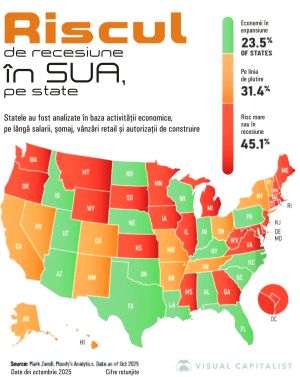After 15 years of activity, the Pilon II private pension funds have around 8.1 million participants, 117 billion lei accumulated, of which three quarters represent the contributions transferred into the system and one quarter (over 30 billion lei) represents the net profit added to the accounts of those who contribute to private pension funds, according to yesterday's presentation by the president of the Association for Privately Administered Pensions in Romania (APAPR), Radu Crăciun, held on the occasion of an event hosted by the BNR.
At the same time, private pension funds in Pillar II have already made payments totaling 1.7 billion lei to 130,000 beneficiaries, a figure expected to exceed two billion lei by the end of 2023 and continue to grow exponentially in the years following, according to the presentation of the president of the Association.
Radu Crăciun said: "From APAPR's estimates, if the original Pillar II contribution increase schedule were followed, the value of private pension accounts for a full contribution period should have been 36% higher. In order to at least partially remedy this situation, it is necessary to resume the process of increasing contributions to Pillar II. An important first step is that of 2024 when, according to the commitments made by Romania through the PNRR, the contribution should increase from 3.75% to 4.75% of the Romanians' gross income".
Governor Mugur Isărescu stated that, according to the vision of the World Bank, with which the BNR members agree, a pension system based on several pillars is better able to meet the needs of society.
"After 15 years, private pension funds are now the most important actor in the financial sector after banks, the money managed by these funds - about 25 billion euros at present - representing the second most important financial asset of the population, after bank deposits. The assets of the pension funds represent a historical accumulation of Romanian capital, which can also be found in the development of the Romanian capital market", said the governor.
Dan Armeanu, Vice President of the Private Pensions Sector within the Financial Supervisory Authority (ASF), highlighted the results of Pillar II: "Over the past 15 years, the private pension system in Romania has become the most important component of the non-banking financial market , proving its effectiveness by substantially increasing the performance of private pension funds, with private pension fund assets reaching 8.3% of GDP. The annualized return achieved from the beginning of the system until now was 7.55%, higher than the inflation rate for the same period of 4.35%, and the return achieved in the last year was 18.51%, higher than the inflation rate of 8, 83%".
Ionuţ Dumitru, university professor at the Academy of Economic Studies, pointed out that in our country, the dependence rate of contributors/beneficiaries in the public pension system (Pillar I) is the most unfavorable in the European Union, both for demographic reasons, but also as a result of inappropriate fiscal motivations.
"Romania has a major structural problem in the labor market, the number of contributors to the budget, in particular to the public pension budget, being the lowest among the EU27 countries (relative to the potential pool of available labor force). This situation makes the dependency ratio of contributors/beneficiaries in the public pension system (Pillar I) the most unfavorable in the EU27, both for demographic reasons, but also as a result of inappropriate fiscal motivations. The demographic figures are expected to deteriorate even more in the medium and long term, which makes supplementing the pension from Pillar I with pensions from Pillars II, III and the occupational pensions an urgent necessity for Romania", explained Ionuţ Dumitru.
For his part, Adrian Codirlaşu, vice-president of CFA Romania, pointed out that, according to the calculations of the association he represents, Pillar II of pensions has an efficiency for contributors of three to one compared to the pillar of public pensions.
"Since its establishment, Pillar II of private pensions has brought value to contributors, generating returns in real terms for them. Thus, from CFA Romania's calculations, Pillar II of pensions has an efficiency for contributors of three to one compared to the pillar of public pensions (Pillar I). The solution to ensure a sustainable pension system is the gradual conversion to a funded pension system (Pillars II and III), which is able to ensure both equity for contributors and real positive returns for the money thus saved by them", said the vice-president CFA Romania.
• Mugur Isărescu, BNR: "Demographic developments in Romania were the main reason for the creation of the private pension system"

Demographic developments in our country were probably the strongest reason for the creation of the private part of the pension system, said the Governor of the National Bank of Romania, Mugur Isărescu, adding that, currently, the money managed by private pension funds is the second most important financial asset of the population.
The Governor stated: "After the year 2000, the accession process to the European Union provided the favorable framework for the acceleration of decisions, which led to the construction of the three-pillar pension system, which we have today. The essence of the reform consisted in the creation, alongside the public pension system, based on the state insurance budget, of some pension funds based on accumulation and capitalization, to supplement the public system. Today, the system consists of the public pillar, without capitalization, the private pillar II, which is mandatory , and private pillar III, which is optional".
Mugur Isărescu added: "In time, the demographic developments in Romania were probably the strongest reason for the creation of the private part of the pension system. Pillars II and III were also created to reduce pressures on the public pension pillar. But there were also reasons for the synergy emerging between the public and private systems, as well as those for the potential to accommodate people's diverse preferences for post-retirement living standards."
According to the governor, at the OECD level, assets managed by private pension funds represent on average approximately 65% of GDP, while in our country, assets managed by private pension funds represent 7% of GDP.
"Private Romanian pension funds are now, after banks, the most important player in the financial sector. The money managed by these funds represents the second most important financial asset of the population, after bank deposits. At the same time, private pension funds represent a historical accumulation of Romanian capital, which can also be found in the momentum taken by the capital market in Romania", said Isărescu, who gave the example of Hidroelectrica's public offer in the summer.
"This IPO, of such magnitude, it was said at the time, would have been unthinkable on the Bucharest Stock Exchange, a few years ago. This year the IPO was possible due to the fact that these accumulations appeared from the pension funds. Private pension funds have contributed essentially to the success of other IPOs, for example Electrica, Romgaz, Nuclearelectrica. Also, in the 15 years since its establishment, the private pensions sector has become one of the important creditors of the Government, holding a share of almost 8% of the public debt issued by the state treasury", the governor said.
Isărescu also emphasized that, according to the UN, population aging has a worrying dimension throughout the world. "In 2018, for the first time, the population aged 65 and over exceeded the number of children under the age of five, and the population aged 80 or over was 146 million in 2019 and it is estimated to reach 426 million in 2050. These developments show both the magnitude and the complexity of the problem to which not only we, but all countries must respond, with the help of adequate pension systems, whose components, public and private, are complementary", said Mugur Isărescu.
• Radu Crăciun, president of APAPR: "If the schedule for the increase in Pillar II contributions was followed, the value of the pension accounts would have been 36% higher"

The increase in contributions to mandatory private pension funds (Pillar II) was not respected according to the initial planning, stated Radu Crăciun, the president of the Association for Privately Administered Pensions in Romania (APAPR), stressing that, if the original schedule had been respected, the value of the accounts of private pension for a full contribution period should have been 36% higher than at present.
The president of APAPR said: "The evolution of the contributions, as originally planned, was different. Basically there was an increase after which there was a major correction. I mean the percentage of the gross salary that was transferred. Now we are in some recovery process and I hope that starting next year we will see this increase from 3.75% to 4.75%, which was legalized by the Government and was part of the commitment that Romania made taken through PNRR".
According to the data presented by the president of APAPR, according to the initial planning, the contribution to Pillar II should have reached, as early as 2016, 6% of the gross income of employees, compared to 3.75%, as it is currently.
"In the 15 years, someone who had the average salary in the economy and who contributed month after month, should have today somewhere around 36,000 lei. If the graph of the contribution increase had been the planned one, the amount he would have had in his account would have been 49,000 lei, so 36% more", said Radu Crăciun.
According to the presentation of the president of APAPR, the amount of contributions transferred between 2008 and 2023 (estimate) will be 91.8 billion lei, and the contributions not transferred would amount to 39.5 billion lei.
Radu Crăciun added: "There were other deviations from the original plan, for example the removal of certain categories of employees from the contribution from Pillar II. Employees in construction are excluded from contributions to Pillar II, employees in agriculture, in the food industry and more recently, unfortunately, those in IT. We will reach, following the exemption of IT-scientists from contributions, approximately one million Romanians who will no longer contribute to Pillar II for a period of time, which is not to their advantage in retirement".
According to the APAPR president, there were also certain legislative elements that did not support the original plan. "For example, the private pension payment law should have been implemented according to the law since July 1, 2009. Unfortunately, there is no such payment law at the moment either. The Pillar III deductibility has been unchanged for 14 years. In these 14 years, the average net salary in the economy increased 3.6 times, the deductibility did not increase, which of course discourages long-term saving of the population, which now has a significantly higher saving power. Unfortunately, the occupational pensions that operate in other countries have been legislated for two years (n.r. in our country), but they have absolutely no tax treatment to their advantage and are therefore totally unattractive", said Radu Crăciun.
However, Pillar II of pensions reached in September 2023 net assets under management of 117.1 billion lei, of which 30.3 billion lei is investment income (net of commissions). The system had 8.1 million participants (of which 4.1 million were active), and the payments made amounted to 1.7 billion lei (to 130,000 beneficiaries).
According to the presentation of the president of APAPR, since its establishment, Pillar II has performed substantially above inflation, despite the financial crises and adverse political decisions, with an average annual return of 7.57%, and currently 25% of the managed assets represent the investment gain. According to the presentation, if the pension funds earned 30 billion lei for the citizens of our country, the cumulative balance of the administrators' profitability is negative, more than 70% of their expenses being mandatory by law.
APAPR estimates that, probably in the next five years, the assets of Pillar II will double, reaching the equivalent of 50 billion euros. "The question is - how do we put this money to work?" concluded Radu Crăciun.
• Dan Armeanu, ASF vice president: "The private pension system has become the most important component of the non-banking system in Romania"

The private pension system has grown in the 15 years of its existence and has become the most important component of the non-banking system in our country, said Dan Armeanu, the vice-president of the Private Pension Sector within the Financial Supervisory Authority (ASF), adding that, in terms of absolute value, pension fund assets have increased over the past five years by almost two and a half times, to a record 24.5 billion euros.
Dan Armeanu stated: "In the 15 years of its existence, the private pension system has grown from one period to another and has become the most important component of the non-banking system in Romania. The private pensions market is the largest among the three markets supervised by the ASF, with an asset share of approximately 8.3% of GDP at the moment, followed by the capital market with an asset share of approximately 4.8% of GDP and the insurance market, unfortunately with a share of only 2% of GDP".
The vice-president of the ASF added: "The private pensions market had an accelerated development in the last five years, managing to put on average approximately 1% of GDP in assets, and from the point of view of absolute value, the assets of pension funds have increased in the last five years almost two and a half times, from ten billion euros in assets in 2018 to a record value this year of around 24.5 billion euros, an all-time high for the pension system. In the 15 years of its existence, the private pension system has contributed to economic growth on average between 0.2 and 0.5 percentage points. From the point of view of long-term development, through the investments that the private pension system makes in the real economy, through the financing of Romanian companies, through the payments ensured in the economy, they all have an implicit impact on the potential GDP, and the calculations show that the impact on potential GDP is about 0.3 percentage points".
According to the ASF official, the private pension sector together with the banking sector represent the main sources of financing the domestic public debt. "The private pensions sector, with an 8.3% share of assets, provides around 22% of the internal financing needs, and the banking sector, with a 50% share of assets in GDP, provides more than 44% of financing internal debt. The two sectors together finance more than 66% of the domestic public debt," said Dan Armeanu.
On the other hand, on the capital market, private pension funds represent practically the largest institutional investors, with investments of approximately six billion euros, according to the ASF official. "It provides approximately 15% of the stock market capitalization and between 13 and 17% of the liquidity of the Bucharest Stock Exchange. The shares of Romanian companies listed on the BSE have a weight in the portfolio structure of approximately 24%, increasing by approximately five percentage points in the last five years", stated Dan Armeanu, adding: "The development of the Romanian capital market would not have been possible without the existence and contribution of private pension funds in Romania. The importance of this private pension system in the development of the stock exchange was best seen in the listing of Hidroelectrica only on the Bucharest stock exchange, where the pension funds subscribed almost one billion euros, more than 50% of the offer".
According to the ASF official, in the 15 years from the beginning of the system until now, based on the evolution of the VUAN, the yield is up to 7.4%, a positive real yield, almost twice the inflation rate, of approximately 4, 3%. "Furthermore, the yield from the last year calculated in September, also based on the evolution of the VUAN, is somewhere around 18.8%, more than twice as high as the inflation rate in September, of 8.8%. All these elements highlight the fact that the private pensions




























































